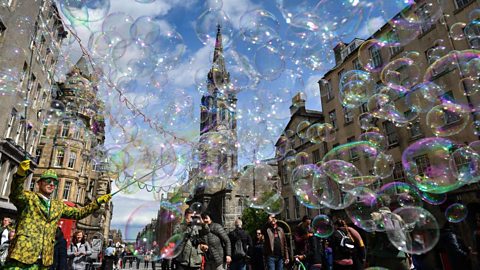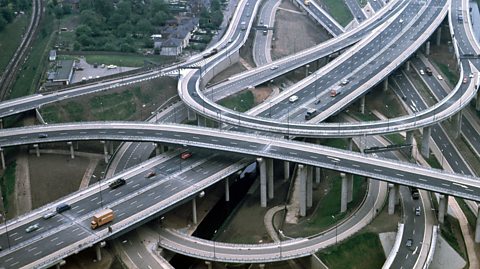Even if you have never set foot in them, thereâs a chance you will have heard their name spoken somewhere.
The UK is packed with streets which have become well-known beyond their home cities, such as Downing Street in London, Glasgowâs Sauchiehall Street and Manchesterâs Canal Street.
Behind many names, there also lies a story. ±«Óătv Bitesize takes a look at some of the roads and thoroughfares you may be familiar with, and whatâs in their names.
The Royal Mile
Anyone who has attended the Edinburgh Festival Fringe is likely to have seen The Royal Mile, in the heart of Scotlandâs capital. During festival time, there are street performers showing off their skills at almost every turn.
Part of the cityâs old town, The Royal Mile runs between Edinburgh Castle and the Palace of Holyroodhouse, the official residence of the UK monarch in Scotland.

Its name, perhaps unsurprisingly, is linked to the monarchy too. The Royal Mile has been a traditional processional route for kings and queens for more than 500 years. In June or July of each year, the Queen spends Holyrood Week (or Royal Week) in Edinburgh. On arrival, she is welcomed to the city by the The civic head of some of the cities in Scotland, similar to a mayor. Edinburgh, Glasgow, Aberdeen and Dundee have a Lord Provost. during the Ceremony of the Keys. Holyroodhouse is the venue for an A ceremony where someone formally receives an honour or rank. One example is receiving an OBE or MBE from a member of the Royal Family at one of the royal palaces. during the Queenâs stay, which recognises Scottish people and residents who have made significant contributions to society.
The Welsh Streets
Surprisingly, this network of terraced houses are not to be found in Wales. Theyâre actually a short bus ride away from Liverpool city centre.
The Victorian houses were built in the late 19th Century in the Toxteth area of the Merseyside city. Welsh workers were involved in the construction, and they were specifically built as homes for people who had travelled from Wales to Liverpool to find work.
Named after Welsh landmarks and places, the map of the Welsh Streets include Powis Street, Pengwern Street and Madryn Street. The latter also has a very different place in history as it was the birthplace of future Beatles drummer Ringo Starr in 1940. Powis Street enjoyed another life much later on. Painted black, it featured as Watery Lane in the ±«Óătv TV series Peaky Blinders.
After a period of dereliction, The Welsh Streets underwent significant reinvestment and redevelopment, with the first new tenants moving in in 2017.
Fleet Street
Once a byword for Londonâs newspaper industry, Fleet Street began as a watery byway. Its name comes from the River Fleet, which ran from Hampstead Heath to the Thames. In the early 17th Century, it was possible to navigate a vessel down at least part of the Fleet but the river became a victim of the rubbish thrown into the waters. It led to the River Fleet being built over with arches and enclosed in sewer tunnels. This happened by 1766, although the river can still be spotted in certain places today, such as Hampstead Ponds and beneath Blackfriars Bridge.

The first British newspaper, The Daily Courant, was published on Fleet Street in 1702. It went on to be the home of many well-known titles such as the Daily Express and the Daily Mail. Not all titles were based on Fleet Street itself, but could often be found nearby. By the 1980s, most of the major newspapers had moved to premises elsewhere although the last two journalists on Fleet Street, the Sunday Postâs Gavin Sherriff and Darryl Smith, were based there until 2016.
Shankill Road and Falls Road
Take a guided tour around the city of Belfast and youâre likely to be shown the Shankill and Falls roads â usually referred to locally as The Falls and The Shankill.
Both are in the west of Northern Irelandâs capital and their famous murals and peace walls reflect their links to a period of unrest in the country known as The Troubles. Before that, they were a big part in the homes and livelihoods which sprang up around the River Farset - which now flows underground - as Belfast became the home of a thriving linen industry.
The name Shankill comes from the Irish word 'seanchill', which means âold churchâ. Along its 1.5 miles (2.4km) length are mostly shops, with residential streets branching away from it.
Falls Road also gets its name from Irish; âtĂșath na bhFĂĄlâ. This translates as âterritory of the enclosuresâ. The territory referred to in the name was around the same size as the parish of Shankill. As the linen industry grew, homes for workers started springing up in and around the Falls Road.
This article was first published in May 2022.
The Great British Motorways Quiz
If you've ever been stuck on one, we hope you were taking notes.

Cake Britain: Eight traditional treats from around the UK
Ever made Fifteens in a fridge, or tried a slice of Selkirk bannock?

From New York to Blackpool - the sisters who street dance. video
See where Zoe and Zara's passion for dancing has taken them in this clip from C±«Óătv.
